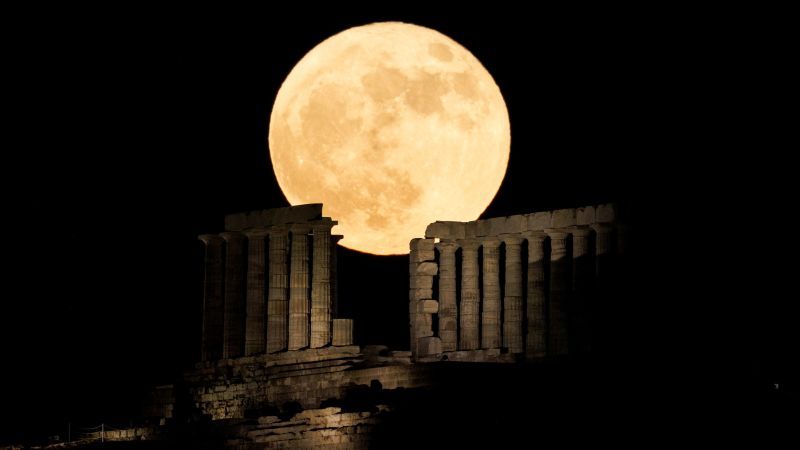June full moon: When and how to see the strawberry moon
Sign up for CNN’s Wonder Theory science newsletter. Explore the universe with news on fascinating discoveries, scientific advancements and more.
CNN —
The strawberry moon will light up the night sky this weekend.
You can watch the full moon’s rise just after sunset in the southeast direction. The orb will reach peak illumination at 11:42 p.m. ET Saturday and appear full for three days, according to NASA. Find out your local peak time using The Old Farmer’s Almanac’s full moon calculator and check the local forecast.
The name of this last full moon of the spring, which is sometimes the first full moon of the summer, has nothing to do with the moon’s appearance or color. The strawberry moon got its name from Native American tribes “to mark the ripening of ‘June-bearing’ strawberries that are ready to be gathered,” according to The Old Farmer’s Almanac, which notes, “As flowers bloom and early fruit ripens, June is a time of great abundance for many.”
This year, according to NASA, some moon gazers will get an additional treat. People in Argentina and the Atlantic Daylight Time zones “eastward across the rest of North America, Europe, Africa, Asia, and Australia to the International Date Line in the mid-Pacific” will see Antares, the most luminous star in the Scorpius constellation, a few degrees right of the moon.
What’s more, at dusk Saturday two striking planets will be on display.
“We can see Venus setting in the west,” said Mike Hankey, operations manager for the American Meteor Society, via email. “This will appear as a ‘very bright star’ near the horizon. It is the brightest object in the sky next to the sun and moon. Mars is also visible just next to Venus and can be seen at dark and will look like a dim reddish star to the top left of Venus.”
June full moon and traditions
People of other regions have also given the June moon names that represent their seasonal or cultural customs — such as the Europeans’ honey moon since June “was traditionally the month of marriage, and is even named after the Roman goddess of marriage, Juno,” according to The Old Farmer’s Almanac.
For believers of Hinduism, this moon and the three days it appears full mark Vat Purnima, when women demonstrate their love for their husbands by “tying a ceremonial thread around a banyan tree,” according to NASA.
The strawberry full moon isn’t your last chance to catch a cool celestial event this year. Here are the full moons, eclipses and meteor showers to watch out for through the rest of 2023.
Full moons and supermoons
Most years have 12 full moons, but 2023 will have 13, with two — which are supermoons — happening in August. Supermoons are brighter and closer to Earth than normal and therefore appear larger in the sky. There are four supermoon events in 2023, including one on July 3 and September 29.
Here are the full moons remaining in 2023, according to the Farmer’s Almanac:
● July 3: Buck moon
● August 1: Sturgeon moon
● August 30: Blue moon
● September 29: Harvest moon
● October 28: Hunter’s moon
● November 27: Beaver moon
● December 26: Cold moon
Lunar and solar eclipses
An annular solar eclipse will occur on October 14 and be visible for people across North, Central and South America. This is when the moon passes between the sun and Earth at or near its farthest point from Earth — making the moon appear smaller than the sun and creating a glowing ring around the moon.
When viewing solar eclipses, wear eclipse glasses to avoid eye-damaging sunlight.
On October 28, a partial lunar eclipse will be viewable by people in Europe, Asia, Australia, Africa, parts of North America and much of South America. In this type of event, the sun, Earth and moon don’t completely align, so only part of the moon passes into shadow.
Meteor showers
There are nine more meteor showers that peak this year, all of which are most visible from late evening until dawn in areas without light pollution. Catch these events on their peak dates:
● Southern Delta Aquariids: July 30-31
● Alpha Capricornids: July 30-31
● Perseids: August 12-13
● Orionids: October 20-21
● Southern Taurids: November 4-5
● Northern Taurids: November 11-12
● Leonids: November 17-18
● Geminids: December 13-14
● Ursids: December 21-22
Source: CNN


